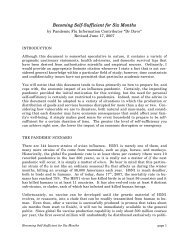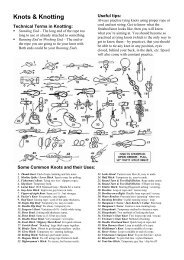( Hand to Hand: Martial Arts ) Aikido ( revised )
( Hand to Hand: Martial Arts ) Aikido ( revised )
( Hand to Hand: Martial Arts ) Aikido ( revised )
You also want an ePaper? Increase the reach of your titles
YUMPU automatically turns print PDFs into web optimized ePapers that Google loves.
Anbo-Jyutsu<br />
The Ultimate Way of the Staff<br />
In the distant future of another time-line, the martial arts had become obsolete in the face of superpowerful<br />
weaponry. As such, they had been relegated <strong>to</strong> mostly ceremonial functions and were rarely if<br />
ever used in actual combat. Many of the more aggressive martial arts died out completely (or lived on<br />
secretly) in those dark times, but at least one new form was created.<br />
Even though humans of the future liked <strong>to</strong> believe themselves free from all violent impulses, they still<br />
required an occasional venting of anger and frustration. Because of the combatant nature of the martial<br />
arts, these ancient practices were deemed worthy of further study; the fact that they required great mental<br />
and physical discipline as well was seen as a great plus. So, sometime in the mid- <strong>to</strong> late 23rd century, an<br />
his<strong>to</strong>rian and student of the martial arts decided <strong>to</strong> create his own form. Well, it wasn't actually that simple<br />
a decision, but it's as good a description as any.<br />
Working with the idea that the martial arts should be a vent for negative emotions and not a means of<br />
self-defense, this his<strong>to</strong>rian (who is ironically unnamed in the his<strong>to</strong>ry texts of later eras) synthesized a<br />
workable form from his knowledge of many older forms. He called this discipline "Anbo-Jyutsu," but<br />
among its practitioners it was often called (wrongly and arrogantly) "the ultimate advancement in the<br />
martial arts." Anbo-Jyutsu is practiced and performed in light-weight armor made out of a material similar<br />
<strong>to</strong> kevlar. Its primary weapon is a staff about five feet long, with a padded weight on one end and a<br />
carved air-whistle on the other. In combat, these staves made a low, throbbing noise counterpointed with<br />
shrill whistles each time it strikes. However, the most stunning thing about this martial art (besides its<br />
impressive appearance) is that it is performed without the benefit of sight! All Anbo-Jyutsu armor is built<br />
with an attached faceplate which can be lowered or raised. In performances, mock battles, and grudge<br />
matches, it is always kept down.<br />
Anbo-Jyutsu has many wide, sweeping, circular motions in it, partly <strong>to</strong> make up for the lack of sight, but<br />
also just for the sake of an impressive appearance. Do not be fooled by thinking this martial art weak just<br />
because it prides itself on appearance; on the contrary, practitioners of Anbo-Jyutsu (who often consider<br />
it a game rather than a combat discipline) equate being good with looking good and can be truly<br />
devastating, both <strong>to</strong> their mock opponents and their real ones.<br />
(Note: If you want <strong>to</strong> use this in a campaign that isn't Phase World/Rifts, arbitrate that a group of Anbo-<br />
Jyutsu practitioners were caught in a transporter accident and sent <strong>to</strong> whatever game world you're using.<br />
Or just move the background [ie: an his<strong>to</strong>rian with a penchant for the martial arts] <strong>to</strong> whatever game world<br />
you're using.)<br />
Entrance Requirements: PP 13; PE 11; MA or PB 12<br />
Skill Cost: 4 years (people can learn Anbo-Jyutsu fairly quickly because of its dependence on the purely<br />
physical aspects of martial arts)<br />
Costume: Light, padded armor for competitions which is fairly useless in real battle (AR 16; 25 SDC);<br />
traditional colors are red and blue, but any are allowed. If actually fighting, the practitioners go with<br />
something comfortable, but stylish, depending on individual tastes.<br />
Stance: Feet planted wide, pointing apart at a 45-degree angle, weight on the balls of the feet rather than<br />
the heel. Arms kept level and steady, holding the staff in a defensive posture.<br />
CHARACTER BONUSES<br />
Add 2 <strong>to</strong> PP<br />
Add 1 <strong>to</strong> PE<br />
Add 1 <strong>to</strong> PS<br />
Add 15 <strong>to</strong> SDC
















